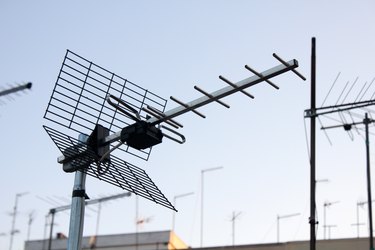
If you're looking to cut the cord with your cable provider or to add local stations that aren't included in your TV bundle, adding an antenna to your home TV setup is a simple and usually cost-effective way to do that. Over-the-air TV signals broadcast on two separate sets of frequencies, which is a minor complication. The specific channels you want to watch may be on one band or the other, and you won't be able to see them without the right antenna.
UHF vs. VHF
Video of the Day
Over-the-air TV signals are broadcast on two different bands, very high frequency (VHF) and ultrahigh frequency (UHF). VHF channels transmit at radio frequencies between 54 MHz and 216 MHz, while UHF channels come at much higher frequencies between 470 MHz and 890 MHz.
Video of the Day
As any ham-radio enthusiast will tell you at great length, your choice of frequency has a lot to do with how well the signal travels. In the days before cable TV took over, most stations broadcast on the VHF band because it was less prone to interference and would carry the signal farther on a given amount of transmission power. Today UHF is more popular because it provides more bandwidth for modern high-definition programming.
Broadcast Frequency and Antenna Design
UHF and VHF radio frequencies operate at different wavelengths. A VHF signal sends relatively large radio waves, while UHF signals are sent on smaller waves that arrive closer together. When we speak of a UHF signal as having a "higher frequency," that's literally what it means.
The elements or prongs of your antenna are directly related to the length of the radio wave. The simple rule is that they're opposites: The bigger the number, the smaller the radio wave and the smaller the elements of the TV antenna that can receive it.
Antennas With Visible Elements
If your antenna has visible elements, you can tell at a glance whether it receives VHF, UHF or both. An outdoor UHF antenna has short elements, just a few inches wide, and they're usually arranged in parallel rows of straight prongs. An outdoor VHF antenna has longer elements, arranged in an easy-to-remember V-shaped pattern. If you see both V-shaped elements and a smaller cluster of straight elements on the same antenna, it receives both signals.
The simplest indoor antenna is the basic rabbit ears design, which receives VHF. A loop-shaped antenna, whether it's arranged horizontally or vertically, is for UHF. Many antennas include both rabbit ears and loops so they can receive both sets of frequencies.
Antennas Without Visible Elements
Some antennas can't be identified visually, either because they're hidden inside a streamlined case or because they're in a nonstandard shape such as flat for wall-mounting. In that case, checking to see which frequencies or channels it receives may tell the story. That information is often on a plate or decal on the antenna itself or in the user's manual. Channels from 2 to 13 are on the VHF band, while UHF TV channels run from 14 to 51.
Choosing a TV Antenna
If you're choosing between antennas or deciding whether an existing antenna can do the job for you, you need to consider two things: the channels you want to get and how strong their signals are.
That's trickier than you might think because Channel 6 Local News might transmit now on – for example – UHF channel 38 rather than VHF channel 6, even though it still shows up on channel 6 so that the station can preserve its branding. There's a page on the Federal Communication Commission's website where you can search your station by call sign and compare its real and virtual channel numbers. You may want a UHF antenna, a VHF antenna or one that does both.
There are also online tools available on enthusiast sites and antenna manufacturers' sites, which tell you how strong a channel's signal is in your area. Based on that, you can choose between a simple and inexpensive indoor antenna, a more potent amplified antenna, or a full-bore outdoor antenna.
- Crutchfield: Choosing the Best HDTV Antenna
- Federal Communications Commission: Antennas and Digital Television
- GetTV Antenna: UHF vs. VHF - A Comprehensive Guide
- Federal Communications Commission: TV Query Broadcast Station Search
- TV Fool: TV Signal Locator
- AntennaWeb: Maximize Your Television Reception